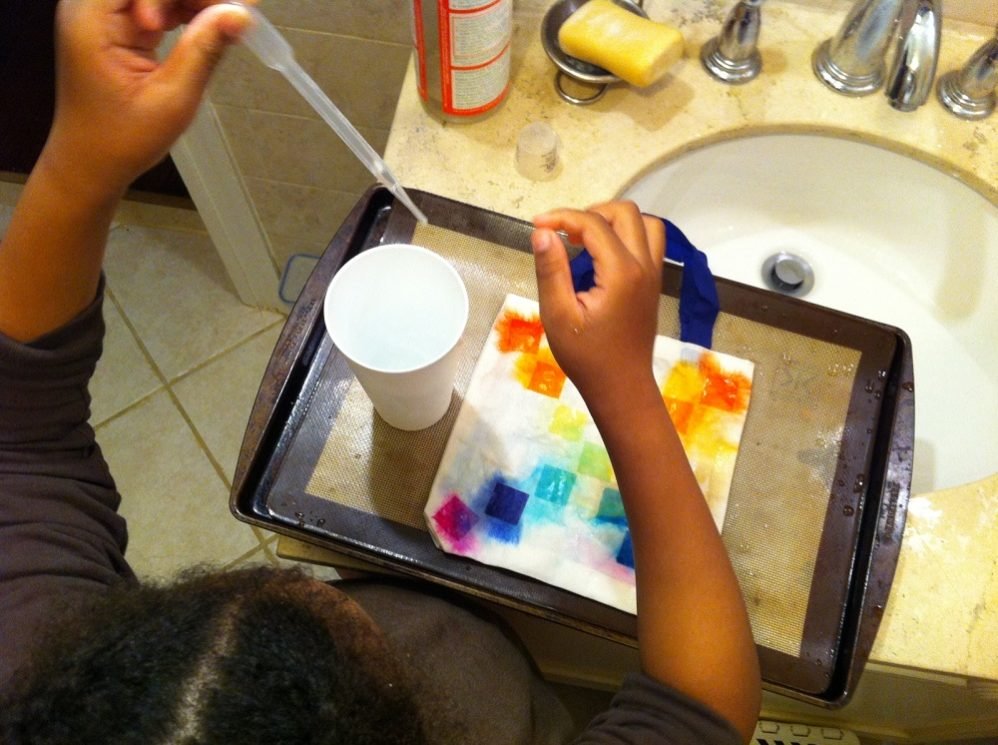Human beings learn how to work around things and cope, so this is neither a rant nor complaint; rather, it is a dilated moment of gratitude and awareness that this crisis is opening our eyes to what we all should’ve been doing already to support the health of ourselves, our communities, and our planet.
We should always wash our hands like surgeons. We should always avoid being out and about without a compelling reason, preserving climate integrity, resources, and time. Rampant consumerism should be reconsidered. Some people already know these things. Now we all have the opportunity to perceive our circumstances clearly. It’s also an opportune time to make an effort and empathize, because as hard as the situation is for me, I can always think of so many people for whom it’s so much harder.
My lovely and empathetic editor asked me to think about the difficulty of facing the pandemic as a parent, especially the mom of a differently-wired kid. There is definitely a lot still to consider when it comes to addressing individuals with (sometimes hidden) disabilities in any global emergency — and other parents who are more knowledgeable than I are doing a great job flagging those moments. Another important lesson from this pandemic will be how to prepare all the people much better for the uncertain times.
While I agree with my editor that parents have an added layer of concern and responsibility during this crisis, I think I’m one of the luckiest people and was better prepared than most. As parents, our job might not be to teach math or reading as we are having to help facilitate now. But it is always to teach our children how to calm themselves down enough to learn; to exercise self-control so they can be permeable; to be respectful enough to let their teachers impart the message. In our home, this has always been the emphasis and our concerted goal since our kids were born.
For so many of the people I know, the situation only got real when schools closed. In my area, the decision was taken a week ago Friday and in the course of one weekend, the private school my kids attend adapted themselves from in-person to distance-learning. The amount of work that went into that transition was not made evident to parents at home, but I could read it in the stretched out smile of the young teacher holding a Zoom meeting for my 10-year-old — with her own baby clutched onto one hip; in the voice of my 8-year-old’s homeroom teacher who, suspicious of technology and likely overwhelmed by her 4 four teenaged daughters scrambling over it in her own house, insisted on calling on the phone instead, to check on her students. But then again, I am always and perpetually aware of how hard teachers work to reach our children at school, every day, year after year.

My two boys are incredibly smart and each one faces some challenges. For those of us with more than one kid, we can get a sense of each one’s personality as it contrasts with their sibling. For those of us with onlys, we get to see them define themselves vis-a-vis the other kids they encounter along their school years. Whatever the family structure, though, all parents are experts in their own children, the things that come easily to them and those that don’t.
My two boys are also very different from one another, of course, and from their classmates. Most salient, the two have vastly different abilities to cope with stress and to communicate and process their worries efficiently. In fact, I would go so far as to say that my younger one has far better coping skills than his same-aged peers. His talent for calm lies in marked opposition to his brother’s paralyzing anxiety and poor coping skills, which tend to be quantifiably lower than his peers to the point of being a disability. This clinical anxiety my older son feels has made some eras of his schooling fraught with worry. He has seen a sleep doctor, who specializes in sleeping disorders in differently-wired children, after he stopped sleeping through the night at the age of 8 due to the excessive worry a rigid teacher created in him.
That whole year — 2nd grade — saw him trapped in a Groundhog’s Day-like cycle of school refusal in which every night he would delay bedtime by any means necessary, then wake himself and us up repeatedly, only to melt down in the morning at the prospect of attending school. While the refusal has never again matched his passion for avoiding that poorly-matched teacher, it resurfaces momentarily during periods of additional stress.
My kid, now 10 and acutely smart in a way that is jaw-dropping but not helpful to his underlying anxiety, had been tracking the spread of Covid-19 and the governmental response to it for a couple of weeks. I had not been telegraphing stress to him, because I am hyper-aware that when I do, it makes him feel so much worse. Experts agree that modeling a sense of calm is the most helpful way to support others who are vulnerable to severe worry. When it comes to children, there is no harm in treating them all like the most sensitive among us, sparing any child added anxiety.
Out of the four people in my family, I’m the highest risk for coronavirus complications, with my history of pulmonary trouble, and I’d much rather be a hard-ass with myself and completely quarantine than have to put that on another member of my family. Besides, I love having my kids with me, love taking them traveling in the summer with no respite from care. I even give mental health days throughout the year, a way in which we healed together from the year of school avoidance.
At first, I thought that my eldest son would benefit from his school’s closure, because of that history between bearing stress and spikes in his anxiety to the point of persuading him to stay home. And though I still believe each parent is an expert in her kid, we are also sometimes wrong. My kid needed to know how homeschool was going to work.
The Diary
Day 1 (Monday): First day of distance learning. I was so excited to let my boys cycle through the tasks teachers had sent at will and to take a little time to enrich the learning with some of the virtual museum tours and read-alouds I had heard of, but I was soon made aware that these special activities had to wait. Both of the kids were temporarily happy not to wake up early or rush through breakfast or wear a uniform, but they each immediately seized on the uncertainty of the situation. “When will we go back”, one wanted to know and “How do I get the rest of my books out of my locker?” asked the other.
My lesson on Day 1 of Covfefe Homeschool involved imparting a lot of explanation of what I knew (like websites to access meetings and teachers’ email addresses), admission and repetition of what I didn’t (like when it would all end and when they could return to school). Most importantly, I realized that parents’ biggest job during Covfefe-19 is to teach and sustain a sense of calm, not common-core math.
I felt gratitude because as the mom of a highly-anxious child who is prone to disregulation, I was well-prepared to set up a home routine, which I would stick to as closely as his teachers do at school. Just being able to answer whether the next block of time would be academic or playful is a pacifying tool. Refraining from sub-dividing those tasks into replaceable modules rather than specific tasks at specific times made the boys’ part in helping create their schedule a great buy-in to the new system. The novelty worked in my favor as well and it was a pretty good day.
Day 2 (Tuesday), included the first Zoom meetings and tele-contact between the boys and their teachers and classmates. I learned that something as simple as a chaotic conversation in which 15 ten-year olds all talk at once can be a comfort to one of said ten-year olds, to the point of setting him up for an amazingly long time of high focus. (I try not to cry when that same 10-year old who was struggling a bit with the fluidity of 4th grade at his school in the beginning of the year mourns that “of course something like this happens once he’s gotten the hang of school.”)
I felt gratitude that I have a job that allows me to spend mornings helping my two kids access various learning platforms on two separate devices; that they get along well enough to keep each other company; that they seem to recognize all their assigned work as something they’ve learned before.
By Day 3, though, the novelty had worn off and the structure we created, edited to fit the teleconferences arranged by teachers was not enough to persuade them to stick to the plan. That plan was further jettisoned when my husband, formerly working out of his office, was sent home when the downtown Miami building closed in preparation for quarantine. Home and idle for the moment, he tried to help. How that looked to my kids was that he agreed with them, that I was taking the whole “homeschool” thing too seriously, and maybe we could lighten up.
Beginning with my gratitude, that day I felt a deep sense of it for having a partner, especially one so directly involved in the raising and education of his sons, and equal participant in our marriage, unafraid to adjust to the situation. As I do so many other times, I marveled at the women and men out there who do this so-difficult thing on their own.
My lesson that day was that after 24 years of being with me, my partner is capable of stepping away from a situation and hearing my side of it, even realizing how we actually agree on the importance of remaining calm over teaching how to multiply decimals or on how far to push the structure of a schedule. He is also equipped to keep himself away from the situation — once he’s been informed that he has been fired from his presumptive post as teacher.
Day 4, then, began much more assertively than the previous day, which fizzled out in the afternoon once I traded in the powerpoint from the science teacher for a little day-drinking. With my husband on household and dog-walking duty, I could concentrate on alternating sitting by one kid, then the other, encouraging each to keep reading, use headphones, fill in the whole space with color, or mute themselves on Zoom when the teacher is speaking. Ideally, we are moving toward their independence, but both still need my help and that’s what I’m here for.
By the afternoon, I was tired. Fortunately, Friday had been scheduled as a teacher planning day from the beginning, so even homeschool was out for the day, giving me plenty of time to think about the lessons of the week and the goals for the next one.
Days off gave us time to catch up on the various resources that have been set up to help families learn and grow, even through times of crisis. I watched a lecture on literature through the Yiddish Book Center website. My kids’ hearts swelled when they connected with peers and family members throughout the week through Zoom and FaceTime. My husband is now fully equipped to work from home, hopefully staying in his own lane. We can watch TED talks and book talks; attend lectures and group lessons; we can even have tele-therapy with our providers, and that’s in addition to time for family meals, no commute to school or work, and never harsh words about how long it takes any of us to put on our shoes.
Though far from ideal, the current situation is full of potential for new growth. Here, we look forward to where it may take us.
For Image credit or remove please email for immediate removal - info@belatina.com




































